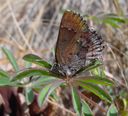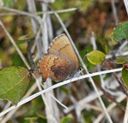Callophrys
Callophrys
Classification
- Phylum: Arthropoda
- Subphylum: Hexapoda
- Class: Insecta
- Order: Lepidoptera
- Superfamily: Papilionoidea
- Family: Lycaenidae
- Subfamily: Theclinae
- Tribe: Eumaeini
- Genus: Callophrys
Pronunciation
How to pronounce Callophrys: //kəˈlɒfrɪs//
These audio files are automatically generated. While they are not always 100% accurate, they are a good starting point.
Images






Summary
The genus Callophrys comprises a group of butterflies primarily known as green hairstreaks, commonly found in North America and Eurasia. Various subgenera display distinct morphological traits and behaviors, leading to a broad diversity within the genus.
Physical Characteristics
Green hairstreaks are tailless butterflies characterized by their green underwings and are known for their vibrant colors.
Identification Tips
Look for the distinct green color on the underside of the wings, which can be confused with the brown or gray of other species. Also, the presence of various subspecies such as elfins, which may have different markings.
Habitat
Various habitats including forests, gardens, and grassy areas, particularly those with specific host plants for larvae.
Distribution
North America and Eurasia, with different species adapted to specific regions and habitats within these areas.
Diet
Larvae primarily feed on various plants, especially those in the family Fabaceae (legumes), and adults often feed on nectar from flowers.
Life Cycle
Complete metamorphosis with distinct egg, larval (caterpillar), pupal (chrysalis), and adult stages. The duration of each stage can vary depending on environmental conditions.
Reproduction
Typically involves seasonal mating, and females lay eggs on or near host plants suitable for their larvae.
Predators
Birds, small mammals, and other insectivorous animals. Some species also face threats from parasitic insects.
Conservation Status
Many species within Callophrys are subject to habitat loss, but specific conservation statuses vary by species.
Ecosystem Role
They play a role in pollination as adults and serve as food for various predators in their habitats during both larval and adult stages.
Economic Impact
Their presence often indicates healthy ecosystems. However, specific economic impacts are minimal unless species affect agriculture or horticulture.
Cultural Significance
Admired for their beauty, they are often featured in local butterfly-collecting events and nature education programs.
Collecting Methods
- Netting
- Observation during mating seasons
- Field surveys
Preservation Methods
- Setting in insect boxes
- Freezing specimens
- Taxidermy for display
Evolution
The genus has undergone changes in classification with some taxa being debated as distinct genera or subgenera.
Misconceptions
Some may confuse Callophrys species with other hairstreaks or blues due to their small size and coloration; they are often misidentified by casual observers.
Tags
- Callophrys
- green hairstreaks
- butterflies
- Lycaenidae
- North America
- Eurasia